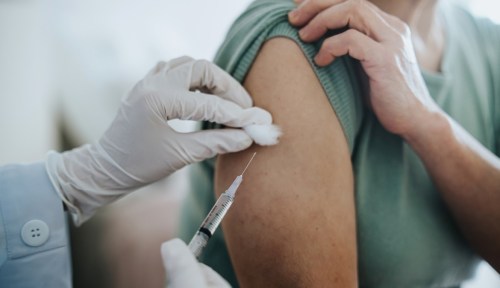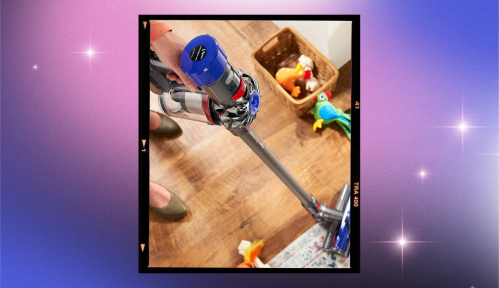It’s safe to say we’re living in a golden age of contraceptives as far as the sheer number of options go. The pill, the patch, the shot, the ring. Implants and condoms and fertility awareness apps that track your safe-to-have-sex days. There truly are more ways to get busy without making babies than ever before. (Choices that are super-effective and side-effect free, however? Or birth control for dudes? Science hasn’t cracked those codes yet, sadly.)
Out of all the players on Team Birth Control’s roster, one in particular has recently emerged as the fan favorite: the intrauterine device, or IUD. The small, T-shaped piece of plastic gets inserted into the uterus, where it works in the background to prevent pregnancy for up to a decade. Some IUDs secrete small amounts of synthetic hormones to get the job done, while others are wrapped in copper, which creates an inhospitable environment for sperm.
If it seems like all your friends are suddenly talking about their IUDs, there’s a reason for it. There was a 22 percent spike in the insertion of IUDs and other long-acting reversible contraceptives (LARCs) in the four weeks immediately following the 2016 election, according to a research letter published Monday in the journal JAMA Internal Medicine. The rate of daily IUD insertions, the letter reports, increased from 13.4 insertions per day per 100,000 women to 16.3 per day per 100,000 women.
“I can tell you, we ask thousands of women about their birth control, and the happiest birth control users are IUD users.” —Kate White, MD, MPH
This recent surge in interest reflects a trend that has been building for over a decade. While the pill is still the most widely-used form of birth control among American women, IUD use has skyrocketed over the past 15 years. In 2002, only 1.5 percent of women used IUDs. Now, a record 4.4 million, or 7.8 percent of all US women, have IUDs—nearly 12 percent of women who use contraception, according to a 2018 research article published in the journal Conception.
“IUDs are definitely more popular than they were a decade ago,” attests Kate White, MD, MPH, who is the associate professor of OB/GYN at Boston University. “There is a ton of evidence about their safety, so more clinicians are apt to offer them as an option to their patients. As women tend to delay having a baby until their late 20s, early 30s, or even later, an IUD provides years of worry-free contraception.”
Safety was the main reason Kerry*, 41, made the switch from the pill to a non-hormonal copper IUD a few years ago—namely, because she was concerned that her go-to form of contraception may not have been so safe. “After being on the pill for around 13 years, I felt really strongly that I didn’t want to be on hormonal birth control anymore,” she says. “I knew there were side effects, like an increased risk of blood clots, and I worried what it would do to my body long-term.” (People who take pills with both estrogen and progestin have an increased risk of developing deep-vein thrombosis, which is why this type of contraception is generally not advised for smokers or those with a history of clotting disorders or other cardiovascular problems.)
After the initial discomfort of having the IUD placed—and one painful period afterward—Kerry says her mood and sex drive have improved and she’s “never looked back.” This experience echoes those of many IUD users. “I can tell you, we ask thousands of women about their birth control, and the happiest birth control users are IUD users,” says Dr. White.
But for every happily-ever-after story like Kerry’s, you also hear about other women who’ve dumped their IUD in frustration after suffering unexpected side effects—infections, heavy cramps and bleeding, incessant spotting between periods, and in very rare cases, even unplanned pregnancies. (This is despite the fact that IUDs are said to be more than 99 percent effective as birth control when properly inserted.) Given that modern IUDs haven’t been around that long in the grand scheme of things—the copper IUD was granted FDA approval in 1988, while hormonal IUDs started rolling out in 2000—I’ve always wondered whether there are any long-term implications of them that we might not know about yet. So, to learn more, I reached out to a crack team of OB/GYNs for intel on the IUD’s history, its pros and cons, and whether there’s anything we might be overlooking in our rush to crown it queen bee of birth control.
The IUD’s fall from grace—and surprise return to the spotlight
If you ask your mom what she thinks of the IUD, there’s a good chance she’ll make the grimacing emoji face. That’s because a few years after IUDs were first introduced in the ’70s, one called the Dalkon Shield was at the center of a pretty big scandal.
“There were valid concerns about the Dalkon Shield because it was associated with an increased risk of infection and poor patient outcomes,” says Jessica Lee, MD, an assistant professor of obstetrics, gynecologic and reproductive sciences at the University of Maryland School of Medicine and an OB/GYN at the University of Maryland Medical Center. “It had to do with the type of material used in the string of the IUD that allowed bacteria to travel up the IUD strings into the uterus.” That particular IUD was said to increase a woman’s risk of pelvic inflammatory disease (PID), as well as pregnancy complications. According to the New York Times, 200,000 women ultimately filed claims against the A.H. Robinson Company, which manufactured the Dalkon Shield, alleging the IUD caused them serious harm (including infertility and miscarriage). The company went bankrupt in 1987.
Dr. White adds that there was another layer to the story—women weren’t routinely screened for infections like chlamydia back then, which can lead to PID if left untreated. Adding the Dalkon Shield to the mix was only fueling the fire.
Obviously, the general public was pretty freaked out about IUDs after this happened, and by the ’80s, insertions of any IUD had plummeted. (The A.H. Robinson Company stopped making the Dalkon Shield after 1974, and in 1980 it advised doctors to remove the device from any women who still had it.) So why have IUDs suddenly found favor again among doctors and patients alike?
For one thing, the women who remember the Dalkon Shield fiasco have mostly aged out of the IUD market, says Felice Gersh, MD, director of the Integrative Medical Group of Irvine, CA. “That generation of women are no longer of reproductive age, so they’re out of the picture,” she explains. “Now you have a new generation of women who have no recollection of the earlier problems that occurred with the IUD.” Basically, women looking for contraceptive options now don’t have the same negative associations that maybe their moms, aunts, or grandmas do.
“I think the tide is turning because we have excellent safety data from the current IUDs on the market, and women who are happy with their IUDs are sharing their stories with their families and their friends.”—Jessica Lee, MD
Dr. Lee adds that there’s a lot of evidence that the old issues with the Dalkon Shield are truly in the past. “The IUDs we have today have been developed to be much safer than the IUDs of the 1970s,” she says. (In fact, they may actually have unexpected health benefits—one recent meta-analysis found that they may reduce the risk of cervical cancer.) “I think the tide is turning because we have excellent safety data from the current IUDs on the market, and women who are happy with their IUDs are sharing their stories with their families and their friends.”
And that evangelizing isn’t just among patients. “The manufacturers of the IUD have really pushed hard with the professional organizations like the American College of Obstetricians and Gynecologists (ACOG), which came out with statements very heavily promoting the use of the IUD,” says Dr. Gersh. Since 2015, the ACOG has publicly considered the IUD and other long-lasting birth control methods “the most effective and safe forms of reversible contraception.” Many doctors are also walking the walk: A 2015 survey found that 42 percent of women’s health care providers use long-range contraceptives such as IUDs, which is about three times that of the general birth-control-using population.
Another factor in its rising prevalence: The Affordable Care Act, which passed in 2010, made the IUD more accessible than ever. The IUD admittedly has a high up-front cost (as much as $1300 without insurance, according to Planned Parenthood) but most plans are now required to cover at least one form of the IUD, making it free or available with a much lower co-pay. You also get your IUD once and it lasts for three to 10 years, depending on the model you get, so even without insurance, you’re only paying that up-front cost once every few years, as opposed to the $600 every year you’d pay for the pill without insurance. “I wish I had a copper IUD placed in college, because I would have saved thousands of dollars in the long run,” says Kerry. “I used to spend up to $100 per month on birth control pills due to my insurance coverage.” Of course, the ACA and its birth control mandate has been threatened with the Trump administration—which partly helps explain the surge of women who sought out IUDs post-election. Many people said they wanted to have their birth control set before their coverage was potentially taken away.
On a more practical level, the “set-it-and-forget-it” convenience factor is also proving a huge draw for women who don’t want to worry about taking birth control in the midst of a crazy day, says Dr. White—especially since the pill and other options are less effective if not taken at regular times every single day. A person gets their IUD inserted, and then doesn’t have to think about it again (no pill, no shot, no diaphragm change) until their appointment a few years later to take it out. That was certainly a big benefit Kerry experienced. “I don’t have to remember to take a pill or go to the pharmacy—not to mention the stress of things like figuring out when to take the pill while in a different time zone,” she says.
Looking beyond the hype
However, one thing that’s overlooked in conversations surrounding IUDs today is that, like any form of birth control, hormonal and copper IUDs come with their own wide-ranging sets of risks and side effects.
There are four kinds of hormonal IUDs, whose names read like the cast of a Disney Channel movie: Mirena, Skyla, Liletta, and Kyleena. They all contain a synthetic hormone called progestin, which is similar to the progesterone our bodies produce, says Kecia Gaither, MD, MPH, FACOG—a doctor who’s double board-certified in OB/GYN and maternal fetal medicine. The difference between each option is the amount of progestin it contains and the length of time it remains effective (up to seven years, says Dr. Gaither). “They work by making cervical mucus thicker and preventing ovulation—so, in essence, sperm can’t get through the thick mucus, nor does ovulation occur,” she says.
In some cases, women stop getting their periods altogether on hormonal IUDs. Olivia, 35, is one of them—she switched to Mirena after experiencing two unwanted pregnancies with the copper IUD and is super happy with it. “I haven’t had a period in five years, which, for someone with awful periods, is pretty much a life-changer,” she says.
Of course, hormonal IUDs do come with some downsides. “They’re often associated with spotting for many months before bleeding settles into a pattern,” says Dr. White, who notes that in some cases, the spotting never ends at all. “And with the hormonal IUDs, a small amount of hormone enters the bloodstream. Most [users] will not feel the effects of this, but some report side effects such as mood changes or hair thinning.”
“Based on the literature and my experiences with patients, there are no predictable effects of an IUD.”—Kate White, MD, MPH
Acne is another common side effect of the hormonal IUD, says Tsippora Shainhouse, MD, FAAD, of Rapaport Dermatology of Beverly Hills. “For women with hormone-related acne, contraceptives like birth control pills that contain both ethinyl estradiol and [progestin] can help manage and prevent acne flares,” she says. “However, hormonal IUDs only contain the progestin component, and this imbalance can actually cause acne in some people. Some artificial progestins, including the levonorgestrel in IUDs, are derived from testosterone, which can trigger sebaceous gland activity.”
As for the copper IUD (ParaGard), it also influences sperm activity and is effective for 10 years. But it does so without impacting hormones. “Non-hormonal IUDs have copper within their makeup, which affects sperm movement. They move away from the copper,” Dr. Gaither explains. The copper IUD is a great option for women who can’t be on hormonal birth control for a medical reason—or those who are wary of synthetic hormones—but they may make periods “longer, heavier, and crampier,” says Dr. White. Stephanie, 31, experienced this when she got the ParaGard. “I was in such debilitating pain from excruciating cramping that, after three menstrual cycles, I had it removed,” she says.
Dr. Gersh explains that this can happen because high amounts of copper can be inflammatory. “Everything we always do in my world of integrative medicine is try to reduce chronic, unintended inflammation,” she says. “We do not want that, and yet here we have something that can create chronic inflammation.”
There’s also a small risk of both types of IUDs poking a hole in your uterus and migrating around your body(!)—but this is rare (like, a 1 in 1000 chance). Other rare, but potential, risks include ectopic pregnancy and infection.
All of this is to say: As with forms of birth control, everyone’s experience with an IUD is different. “Based on the literature and my experiences with patients, there are no predictable effects of an IUD,” says Dr. White. “I joke a lot with patients that you are dating your birth control, you’re not marrying it. You’re giving it a few months and if you don’t like it, you break up with it and find something better.”
The long-term impact of IUDs
There’s one other thing to keep in mind when considering an IUD, says Dr. Gersh. Although current data shows them to be safe, they’re not a time-tested treatment, she says. “We don’t really understand all the long term potentials,” she says, noting that both types of IUDs alter the uterine environment, which could have an unforeseen impact on a woman’s hormone rhythms and reproductive microbiomes down the line. “Nobody’s going to look at a woman who has an IUD now and say, ‘What’s going to happen in 20 years?’ It’s just not how our [pharmaceutical] system works—it doesn’t look long-term.”
Like many integrative practitioners, Dr. Gersh is also concerned that some doctors are using IUDs as a band-aid for symptoms without seeking out the root cause. “A menstrual cycle is a vital sign of female health,” she says. “So if a menstrual cycle is abnormal—irregular, painful, heavy—then that’s a sign that woman isn’t healthy. We should be saying, ‘Lets work on getting you normal, healthy cycles’ instead of just putting in a device.” To be fair, the same could be said for other forms of birth control (like the pill, which is also used for irregular periods). But it’s still something important for women struggling with these symptoms to consider.
That said, not everyone has access to a functional medicine doctor who’s trained to take this approach. And it’s impossible to ignore the fact that IUDs have provided much-needed relief—not to mention super-effective, hassle-free contraception—to many, many women who need it. “You have the right to find birth control that works for you,” Dr. White says. For some people, that’s the IUD. For others, it’s the pill, or the patch, or condoms. That’s the thing about this golden age of birth control: The choice is (and should be) entirely yours.
*Name has been changed for privacy reasons.
Thinking about getting an IUD? Here’s what 5 women wish they knew before taking the plunge. Or check out these other non-hormonal birth control options.
Sign Up for Our Daily Newsletter
Get all the latest in wellness, trends, food, fitness, beauty, and more delivered right to your inbox.
Got it, you've been added to our email list.











